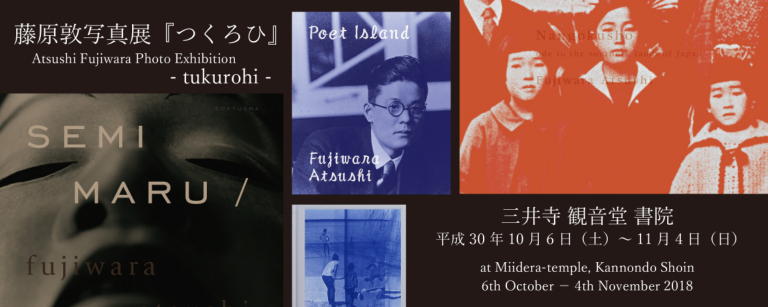『つくろひ』 とは English follows Japanese
「つくろふ」は、太古より用いられた言葉で、【ツクル】(作る、造る)+繰返しの【フ】、または【オフ】(和ふ、逢ふ)との合成語である、という説があります。
金継ぎ(金繕い)という古来の伝統技法では、ヒビが入ったり割れたり欠けたりして損なわれた器に、漆などによる修復がなされ、その痕跡を敢えて残すかたちで、金銀などによる装飾が施されます。それは元の器とは異なる趣をもった器として現れ、我々に新しい在り方という可能性の目を開かせてくれます。茶道においては、器の新しい景色にふさわしい「銘」が授けられることもあります。
藤原の撮る写真には、この金継ぎに似たものが宿っています。瑕疵を含めてあるがままであること。ただし、変化することへの可能性は、常に開かれています。「祈り」のようなものが、そこにはあるのです。
本写真展のタイトル「つくろひ」は、つながりから離脱し、隔絶したまま忘却されようとしている、かけがえのない存在の欠片を探し求め、畏敬の念をもって近づき、呼応しつつ光を当て、そこに立ち現れるものを静かに撮影する、藤原敦の写真行為を表現しようとするものです。
父祖、隣人、先人、ふるさと......。隔たりがあるからこそ、つながろうとする。そんな人間の夢を、ひたむきに追い続けた写真家・藤原敦の旅の軌跡を、どうかご覧ください。
藤原敦写真展@三井寺実行委員会(文責:正岡加代子)
Tukurohi
The photography of AtsushiFujiwara
The Japanese wordtsukurou, which means to mend or patch up, has been in usethroughout the ages, and is suggested to have been formed from two words; tsukuru (to make, put together), and either fu (indicating repetition) or ofu (to combine ormeet).
Tukurohi (phonetically tsukuroi ), the title of this exhibition, attempts to representphotographer Atsushi Fujiwara's quest to identify and approach the fragments of thingsonce considered priceless or cherished but have since been severed from association andmore or less forgotten; and through the act of photography, to quietly invoke, illuminateand reveal them with a spirit of reverence.
A shrine stands at the Barrier of Ausaka (Osaka Check point ) on the border betweenKyoto and Shiga prefectures, which has long been associated with Semimaru, the famedbiwa lute player and poet of the Heian era. The exhibition, featuring pieces from Fujiwara's latest work Semimaru and from his three previous publications, is to be held at theancient Miidera-temple just a short distance from the site.
In the traditional technique of kintsugi (also called kintsukuroi ), the art of mendingcracked or broken pottery and wares with lacquer, the fracture is ornamented with goldand silver to purposely retain those traces. When the vessel reemerges with an airdifferent from its original form, our eyes open to the potential for a new way of being. Insado, the art of the tea ceremony, a title befitting its new "scenery" (as the newlymended form is called) is sometimes bestowed upon the vessel.
There is something much like kintsugi embodied in Fujiwara's photographs. Theembracing of the whole essential being, inclusive of flaws, whilst consistently open to thepossibilities of transformation, it is a quality perhaps akin to prayer.
Ancestors, neighbors, predecessors, homeland... a distance separates us, and this isprecisely why we seek to connect. Photographer Atsushi Fujiwara, who hails from Shiga,has persistently sought after this fundamental dream of humanity. We hope you willenjoy this retrospective of his journey thus far.
Kayoko Masaoka



「文化で滋賀を元気に!プロジェクト参加事業」
「beyond2020 プログラム認証事業」
「第48回滋賀県芸術文化祭・びわ湖大津 秋の音楽祭参加事業」
